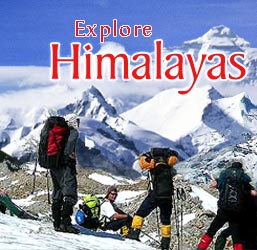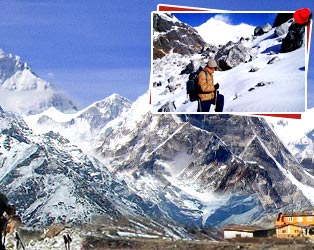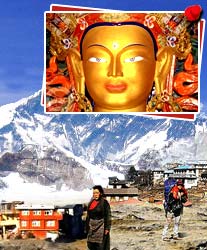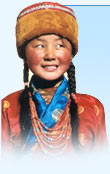Traveling to the Himalayas requires a lot of
preparation and thorough understanding of the place. You should be well
informed from before about the place you are visiting. The Himalayas is
the ultimate for adventure sports like trekking and mountaineering.
Places like Himachal Pradesh offers such varied options for adventure
sports lover like andling to skiing to mountaineering and hang-gliding.
Even Manali, Dharamshala and their adjoining areas, beckon professional
climbers from all over the world to take up some of the toughest, and
most exciting, rock climbing options in the world. You can also indulge
in heli-skiing in places like Hanuman Tibba, Deo Tibba and Chanderkhani
Pass if you want to add some spice and excitement to your holiday. But
the most important is to plan your holiday or adventure trip before hand
so that there is no problem in your trip.
Best Time to Visit
The best time to visit the Himalayas is between mid April to May-June
and also between September to November. It is the best time to plan your
trip to the Himalayas. And if you are going for trekking than all
through out the year you can go depending on your preference of places.
Because of such varied topography of the Himalayas and vastness of the
terrain and difference in altitude of the places trekking tips can be
planned depending on the place. Trekking of low altitude places is
preferred during winter while crossing of high passes is preferred in
summer because the snow line recedes during that time. You can also
combine your adventure trip like river rafting, trekking and
mountaineering together. You should avoid traveling during the monsoon
because of the rains. So you should always plan your trip before and
after the monsoon.
Travel Guide
The trekking group should be small it should not exceed eight to ten
people. Your group should be small because larger group pollutes the
hillside and create administrative problems. Before going for the trip
you should have medical tests to check that you are physically fit and
to avoid height sickness. You should always maintain a first aid box,
which should include basic medicines like fever, headache, nausea,
constipation, burns, diarrhea, sore throat, cough and cold, and cuts
along with bandages and eye lotion and Diuretics. Cold cream should be
applied liberally before the day's walk. It also protects from dryness
of skin in winter. Running stream water should be used for washing.
Above all you should be familiar with the place you are visiting and
prior reading about that place and thorough research on the Internet can
give a detailed understanding of the place.
What to Carry
Some of the necessary items you should carry during the trip are a good
quality rucksack, which has broad straps to hold, foam mattress, a Swiss
knife, sleeping bag, good quality and comfortable walking shoes,
trekking shoes, rain coat because rains are really unpredictable in the
mountains, matchboxes, umbrella, camera film according to the duration
of the trip, water bottle, disposable bags to collect and carry garbage
and torch are some of the essential items to carry for the trip.
What Kinds of Cloth to Carry
Whichever season you go your bag should have warm clothes, as you can
never be sure with the weather. Preferably you should have warm jacket,
woolen shirts, full selves T-shirts, pullovers, and warm inner to wear
inside the cloth. Shorts, long johns, socks, leather jacket, personal
toilet items are the important items to carry.
You can also go for insurance through the standard insurance companies.
It is important to inform the Air force, the IMF, and the local
authorities so that in case of accidents they can send rescue as early
as possible. You should keep them informed of the route of your journey.
What to Avoid
As per the rule you should avoid firewood, including driftwood in the
interest of preserving the thin mountain topsoil. Kerosene should be
brought from the point of origin only. Food should be purchased from
places, which are close to the mountain districts where goods have to be
hauled by road over long difficult terrain.
Rules and Regulations
Trekking up to the height of 4,900 m can be done with prior permission
from the IMF provided no peak is attempted. Taking permission to carry
the camera is also necessary. Taking permission of the local district
magistrate or the Central Home Ministry is necessary to take for four
routes inside the inner line. Foreigners cannot cross the inner line.
General Information
For anyone with good physical condition can go for an excursion on low
altitude ranges with or without trekking.
For trekking to higher altitudes like above 5, 250 m you need greater
physical stamina and for first timers it is not recommended. You should
have past trekking experience.
For any trekking or excursion good physical condition and knowledge of
basic mountaineering skills are essential.



